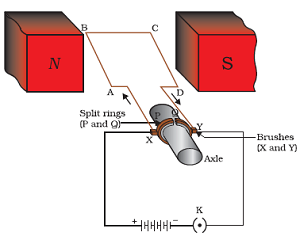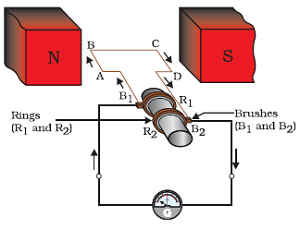Magnetic Effects of Electric Current - Class 10th Science
NCERT Exercise Solution
Question: 1. Which of the following correctly describes the magnetic field near a long straight wire?
- The field consists of straight lines perpendicular to the wire.
- The field consists of straight lines parallel to the wire.
- The field consists of radial lines originating from the wire.
- The field consists of concentric circles centred on the wire.
Answer: (d) The field consists of concentric circles centred on the wire.
Question: 2. The phenomenon of electromagnetic induction is
- The process of charging a body.
- The process of generating magnetic field due to a current passing through a coil.
- Producing induced current in a coil due to relative motion between a magnet and the coil.
- The process of rotating a coil of an electric motor.
Answer: (c) Producing induced current in a coil due to relative motion between a magnet and the coil.
Question: 3. The device used for producing electric current is called a
- Generator.
- Galvanometer.
- Ammeter.
- Motor.
Answer: (a) Generator
Question: 4. The essential difference between an AC generator and a DC generator is that
- AC generator has an electromagnet while a DC generator has permanent magnet.
- DC generator will generate a higher voltage.
- AC generator will generate a higher voltage.
- AC generator has slip rings while the DC generator has a commutator.
Answer: (d) AC generator has slip rings while the DC generator has a commutator.
Question: 5. At the time of short circuit, the current in the circuit
- Reduces substantially.
- Does not change.
- Increases heavily.
- Vary continuously.
Answer: (c) Increases heavily
Question: 6. State whether the following statements are true or false.
- An electric motor converts mechanical energy into electrical energy.
- An electric generator works on the principle of electromagnetic induction.
- The field at the centre of a long circular coil carrying current will be parallel straight lines.
- A wire with a green insulation is usually the live wire of an electric supply.
Answer: (a) False (b) True (c) True (d) False
Question: 7. List three methods of producing magnetic fields.
Answer: Three methods of producing magnetic fields are as follows:
- Current carrying conductors can produce magnetic field.
- Permanent magnet produces magnetic field
- Electromagnet produces magnetic field
Question: 8. How does a solenoid behave like a magnet? Can you determine the north and south poles of a current-carrying solenoid with the help of a bar magnet? Explain.
Answer: A solenoid is a helix-like structure made of a conducting material generally of soft core iron. When current flows through the solenoid; is starts act like a magnet and this magnet produces magnetic field is around it.
To determine the poles of the current carrying solenoid using a bar magnet, North Pole of the bar magnet suspended freely with a thread is brought near both the pole of solenoid. Pole of the current carrying solenoid, which repels the north pole of bar magnet is the north pole of solenoid and opposite of it is south pole.
Question: 9. When is the force experienced by a current-carrying conductor placed in a magnetic field largest?
Answer: A current carrying conductor experiences the largest force when the direction of the current is perpendicular to the magnetic field.
Question: 10. Imagine that you are sitting in a chamber with your back to one wall. An electron beam, moving horizontally from back wall towards the front wall, is deflected by a strong magnetic field to your right side. What is the direction of magnetic field?
Answer: This can be assessed using Fleming's Left Hand Rule. The direction of current is in opposite direction of movement of electron, i.e. towards the back. The direction of current is given by the thumb; as per Fleming's Left Hand Rule. The direction of deflection is given by the index finger, i.e. towards right. Finally, the direction of the magnetic field can be given by the middle finger which is pointing downwards.
Hence, the direction of magnetic field is downwards.
Question: 11. Draw a labelled diagram of an electric motor. Explain its principle and working. What is the function of a split ring in an electric motor?
Answer:
Principle of Electric Motor: The electric motor works on the principle of the behavior of current carrying conductor due to magnetic field.
When a rectangular coil is placed in a magnetic field and current flows through it; a force begins to act on the coil which results in rotational movement of the coil.

Working of Electric Motor:
- The electric current from power supply comes to the coil through the brush X and returns to the power supply through the brush Y. Thus, the flow of current in arms AB and CD of the coil are in opposite directions to each other.
- When the current flows through the arms of the coil; and when the current and magnetic field are in mutually perpendicular directions, the coil AB moves downwards and the coil CD moves upwards.
- It results in coil; along with the axle; moving in anti-clockwise direction.
- After half rotation, the direction of the coil gets reversed and as a result, the half ring Q meets the brush X and the half ring P meets the brush Y. Now the current moves through the coil CDBA. This would lead to a reverse rotation of the coil and axle.
Function of Split Ring: To prevent two ways half rotation and to attain a continuous rotational motion of the axle; the split ring acts as a commutator. It reverses the direction of the current through the coil after every half turn. This leads to a continuous rotation of coil in one direction only.
Question: 12. Name some devices in which electric motors are used.
Answer: Electric fan, mixer grinder, tape recorder, CD player, hard disk drive, washing machine, cooler, toy car, vacuum cleaner, etc. are some of the devices in which electric motors are used.
Question: 13. A coil of insulated copper wire is connected to a galvanometer. What will happen if a bar magnet is (i) pushed into the coil, (ii) withdrawn from inside the coil, (iii) held stationary inside the coil?
Answer: When a coil of insulated copper wire is connected to a galvanometer; following observations can be seen:
(i) When the bar magnet is pushed into the coil, galvanometer would show deflection.
(ii) When the bar magnet is withdrawn from inside the coil, the galvanometer would show deflection.
(iii) When the bar magnet is kept stationary inside the coil, there would be no deflection in the galvanometer.
The deflection in the galvanometer is the result of induced current in the coil. Electromagnetic induction happens when the coil and the magnet are in relative motion.
Question: 14. Two circular coils A and B are placed close to each other. If the current in the coil A is changed, will some current be induced in the coil B? Give reason.
Answer: When two circular coils A and B are placed close to each other and the current in coil A is changed, there will be induction of current in coil B. This happens because there is a change in magnetic field of coil A; due to change in current in coil A. This leads to induction of electric current in coil B.
Question: 15. State the rule to determine the direction of a (i) magnetic field produced around a straight conductor-carrying current, (ii) force experienced by a current-carrying straight conductor placed in a magnetic field which is perpendicular to it, and (iii) current induced in a coil due to its rotation in a magnetic field.
Answer:
(i) Right hand thumb rule which states that that if one holds a straight current carrying conductor with right hand such that the thumb points towards the direction of current, then fingers will wrap around the conductor in the direction of field lines of the magnetic field.
This rule determines the magnetic field produced around a straight conductor carrying current.
(ii) Fleming's Left Hand Rule, which states that if the first finger points in the direction of magnetic field and second finger in the direction of current, then the thumb will point in the direction of motion or the force acting on the conductor.
This determines force experienced by a current-carrying straight conductor placed in a magnetic field which is perpendicular to it
(iii) Fleming's Right Hand Rule, which states that if the forefinger indicates the direction of the magnetic field and thumb shows the direction of motion of conductor, then the middle finger will show the direction of induced current.
This rule determines the current induced in a coil due to its rotation in a magnetic field.
Question: 16. Explain the underlying principle and working of an electric generator by drawing a labelled diagram. What is the function of brushes?
Answer: Electric generator is a device which converts mechanical energy into electrical energy. Thus, electric generator works in the opposite way as an electric motor.

Working of Electric Generator
- When the axle is rotated in order to move the coil; the arm AB of the coil moves up and the arm CD moves down.
- Due to Fleming's Right Hand rule, electric current is induced which flows from AB to CD and thus the current moves from the brush B2 to B1. Thus, the induced current moves in the direction ABCD.
- Large number of turns; in the coil; results in add-on effect to produce a large amount of current.
- The brushes in an electric generator pass on the induced current to the output wire.
Question: 17. When does an electric short circuit occur?
Answer: When positive and negative wires touch each other, there is a sudden decrease in resistance and a commensurate increase in electric current. This leads to sparks and even fire. This phenomenon is called short circuit. The wires get damaged over a period of time or due to some mechanical reason; like abrasion. This removes the insulation from around the wires and thus wires can get exposed. Short circuit can be very dangerous.
Question: 18. What is the function of an earth wire? Why is it necessary to earth metallic appliances?
Answer: The earth wire is attached to the metallic body of an electrical appliance. This ensures that any leakage of electric current is transferred to the earth through the earth wire. This helps in preventing accidental electric shock while using electrical appliances having metallic bodies, such as refrigerator, electric iron, etc.